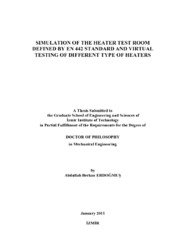Please use this identifier to cite or link to this item:
https://hdl.handle.net/11147/2876Full metadata record
| DC Field | Value | Language |
|---|---|---|
| dc.contributor.advisor | İlken, Zafer | - |
| dc.contributor.author | Erdoğmuş, Abdullah Berkan | - |
| dc.date.accessioned | 2014-07-22T13:48:32Z | - |
| dc.date.available | 2014-07-22T13:48:32Z | - |
| dc.date.issued | 2011 | - |
| dc.identifier.uri | http://hdl.handle.net/11147/2876 | - |
| dc.description | Thesis (Doctoral)--Izmir Institute of Technology, Mechanical Engineering, Izmir, 2011 | en_US |
| dc.description | Includes bibliographical references (leaves: 166-169) | en_US |
| dc.description | xix, 180 leaves | en_US |
| dc.description.abstract | Heat outputs of radiators are determined experimentally in specific conditions. Many standards have been developed to identify test conditions. EN442 standard specifies test room properties, temperature measurements and heat output calculations for radiators. In this study, the heat dissipation capabilities of three different panel radiators were determined by using numerical methods. The height and length of the tested radiators were 600 mm and 1000 mm, respectively. An experimental study was conducted in the standard test room in order to determine boundary conditions for computational study and verify numerical results. Tests were carried out in three different operating conditions. Twelve measurements were performed in each condition when test room reached steady state. Turbulent typed air flow in the test room and water flow inside the tested radiators were simulated. Temperature and velocity contours in virtual test room are also investigated in this study. Non uniform temperature distribution on the front surface of tested radiators was observed. It is seen that the symmetricity in velocity contours is distorted by using more complex radiator models and increasing excess temperature. The difference between experimental and computational heat output fluctuates between 0.4% and 13.6% for the simplest model, 3.4% and 11.1% for the second radiator, 4.5% and 12.9% for most complicated model investigated in this study. Good results are obtained for the excess temperature of 50oC and 60oC. For the lowest excess temperature, results are also in acceptable range. The study shows that computational methods can be applicable in the design of new heater types. | en_US |
| dc.language.iso | en | en_US |
| dc.publisher | Izmir Institute of Technology | en_US |
| dc.rights | info:eu-repo/semantics/openAccess | en_US |
| dc.subject.lcsh | Heat engineering--Research | en |
| dc.subject.lcsh | Heat engineering--Standarts | en |
| dc.subject.lcsh | Radiators | en |
| dc.subject.lcsh | Heat--Transmission | en |
| dc.title | Simulation of the Heater Test Room Defined by En 442 Standard and Virtual Testing Og Different Type of Heaters | en_US |
| dc.type | Doctoral Thesis | en_US |
| dc.department | Thesis (Doctoral)--İzmir Institute of Technology, Mechanical Engineering | en_US |
| dc.relation.publicationcategory | Tez | en_US |
| dc.identifier.wosquality | N/A | - |
| dc.identifier.scopusquality | N/A | - |
| item.fulltext | With Fulltext | - |
| item.grantfulltext | open | - |
| item.openairetype | Doctoral Thesis | - |
| item.languageiso639-1 | en | - |
| item.cerifentitytype | Publications | - |
| item.openairecristype | http://purl.org/coar/resource_type/c_18cf | - |
| Appears in Collections: | Phd Degree / Doktora | |
Files in This Item:
| File | Description | Size | Format | |
|---|---|---|---|---|
| T000858.pdf | DoctoralThesis | 6.35 MB | Adobe PDF |  View/Open |
CORE Recommender
Page view(s)
432
checked on Jul 14, 2025
Download(s)
388
checked on Jul 14, 2025
Google ScholarTM
Check
Items in GCRIS Repository are protected by copyright, with all rights reserved, unless otherwise indicated.